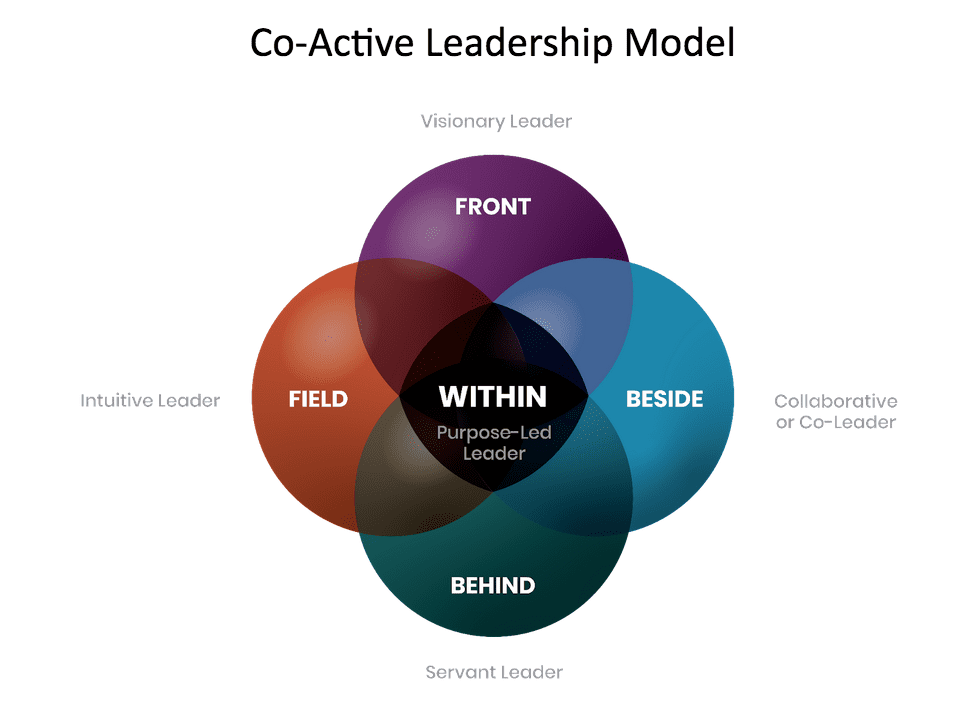How Does Servant Leadership Build Strong Organizations (and strong people)?
Servant leadership empowers the brilliance of others. It’s being a champion for your people, uncovering their unique strengths and talents, seeking out opportunities for them to grow and shining a spotlight on their value, contribution and potential. It’s a commitment to being aware of your own impact and making it your mission to harness your influence for the benefit of those you lead.
This article will explore:
- What is servant leadership?
- Is servant leadership effective leadership?
- When should you choose (or not choose) servant leadership?
- What are the principles of servant leadership?
- Servant leadership vs. traditional leadership
- How can serving others help you succeed?
What is Servant Leadership?
Like conscious leadership, servant leadership isn’t so much a technique as it is an approach. It also isn’t something you have to choose as your one-and-only style of leadership. Rather, it’s an approach to weave into your overall way of being as a leader, and as a person.
If you look at the co-active leadership model below, for example, you’ll see it includes 5 dimensions: in front, beside, in the field, behind and within. Each of the dimensions is equally important, and are meant to be leaned into as the situation demands. This requires practicing conscious, intuitive response-ability to assess what’s needed and when, and being open to exploring missteps and learning from them.

In terms of co-active leadership, servant leadership is a form of leading from behind. In servant leadership, leaders put others first, especially when it comes to celebrating success, sharing opportunities, seeking out ideas and so on. A servant leader assumes that everyone around them is naturally creative, resourceful and whole, and makes it their mission to ensure everyone has what they need to grow, succeed and care for themselves – to bring their natural brilliance forward, for the good of themselves, the team and the organization.
What is an example of servant leadership? Let’s say that a report needs to be presented to a major client every week. A servant leader would see this as an opportunity for a team member to grow their skills and experience, as well as build their personal network and gain esteem within the organization. They would also recognize that it serves the organization for more people to be skilled at dealing with high profile clients. The servant leader would coach their team member, ensure they have the necessary tools and information, introduce them to the client if necessary, and express their enduring trust in the person – not that they will be perfect, but that they will do their best, learn from mishaps, and continue to do better and better.
Is Servant Leadership Effective Leadership?
 In my many years of coaching, I have worked with a diverse mix of professionals – from entrepreneurs and small business owners, all the way up to Fortune 100 leaders, and across a variety of industries. What I’ve learned is that so many people are ready for change, BUT so many people are also caught up in the idea that concepts like servant leadership just can’t be effective.
In my many years of coaching, I have worked with a diverse mix of professionals – from entrepreneurs and small business owners, all the way up to Fortune 100 leaders, and across a variety of industries. What I’ve learned is that so many people are ready for change, BUT so many people are also caught up in the idea that concepts like servant leadership just can’t be effective.
I get it. That old, carrot and stick style of leadership can sound so simple and effective. You do well, you get rewarded. You don’t, you deal with consequences. Simple, right?
And… ineffective. What’s missing from that style is an understanding of why people do well. What really motivates them? What sparks creativity? What encourages collaboration?
Guess what? It isn’t fear, and it isn’t money. At least not for tasks that require even an ounce of creativity. And there’s science behind that. I won’t go into the research and evidence here because Dan Pink did an amazing job of covering that in his renowned 2009 TED Talk. I highly recommend watching it because, as he says, “This is one of the most robust findings of social science, and also one of the most ignored.
Servant leadership is effective, and we need to stop ignoring the science that proves it. But how? In his book, “Leaders Eat Last”, Simon Sinek takes a deep dive into what it means to lead from behind. In his view, it’s about seeing leadership as a responsibility, not a rank.
“Leaders Eat Last” is a favorite of mine, as it takes a truly holistic approach, even exploring the impact of brain chemistry on workplace engagement. Specifically, the roles of endorphins, dopamine, serotonin and oxytocin, what triggers their production, and their critical role in cultivating trust, cooperation, motivation, goal achievement, altruism and much more. Sinek explores these within the context of creating cultures of safety that actively do away with cliques, office gossip, toxic forms of competition and other issues that are often the byproduct of carrot and stick leadership.
Sinek uses the example of Jack Welch, former GE CEO, in comparison with former Costco CEO, Jeff Sinegal. Whereas Welch opted for a leadership approach of profit before people, Sinegal put people first and focused heavily on the well being of employees. Both companies came out profitable, so which approach was better? The answer is in the rise and fall of stock prices. GE’s stock was unstable, rising and falling again and again. Costco’s, on the other hand, experienced steady, stable growth. Which company would you bet on long term?
“Leaders Eat Last” is another great resource if you’re interested in the science behind why this style of leadership is effective, and I can’t recommend it enough for further reading.
When Should You Choose (or not choose) Servant Leadership?

So, if servant leadership is one dimension of an overall approach, and if it’s an effective dimension that fosters the growth and development of others… When is it not the appropriate approach?
Let’s look at our example of presenting a weekly report to a major client, and imagine the client is known to be toxic. They are overly demanding, critical and even rude, bordering on aggressive. Ideally, the client would be dropped. Their toxicity is terrible for the well-being of your people and your organization. But, let’s assume that for some reason, you need to keep this client. Servant leadership would not be the right choice here. Instead, you would probably want to lead from the front in order to shield your people from the toxic client.
As Nelson Mandela wrote, “It is better to lead from behind and to put others in front, especially when you celebrate victory when nice things occur. You take the front line when there is danger.”
We could also imagine the major client scenario another way. You’re mentoring a team member. You know they don’t yet have the experience to handle the weekly report solo, but you recognize that they could benefit from being involved. In that scenario, you might choose to lead from beside by partnering with your mentee, working on the report together, and having them accompany you to the weekly meeting as a partner.
Servant leadership – or leadership from behind – is for when it truly serves your team, allowing them to shine their unique strengths and grow their expertise. If servant leadership would leave people floundering or caught in the line of fire, you need to reach for a different approach.
What Are the Principles of Servant Leadership?
The concept of servant leadership was first described in 1970 by business leader Robert Greenleaf, who went on to found the Greenleaf Center for Servant Leadership. From Greenleaf’s original essay and teachings, current Greenleaf Center CEO, Larry C. Spears, went on to clarify the 10 principles of servant leadership:
- Listening
- Empathy
- Healing
- Self-awareness
- Influence
- Conceptualization
- Foresight
- Stewardship
- Commitment to the growth of others
- Community building
Let’s explore each of these:
- Listening – When someone is speaking, you give them your full, undivided attention, and expect your team members to give each other the same courtesy. But listening is so much more than hearing what people say. It’s also validating their perspective and building your question-asking skills to encourage people to talk openly.
- Empathy – Empathy goes hand-in-hand with listening, and with noticing what’s going on with your team members. Practice tapping into your intuition and bringing things out into the open. That could sound like, “I notice you’ve been on edge lately. What’s up?” The servant leader’s focus is on ensuring people have what they need to succeed. Ask with curiosity and a desire to help; never with judgment. Respond with compassion. People are human beings with human experiences. There is always space for what’s human.
- Healing – The servant leader recognizes that everyone has emotional wounds to heal, and physical bodies to care for. They understand that someone who doesn’t speak up, for example, may be struggling with fears rooted in past workplace or personal experiences. Someone who is consistently late may be struggling with health issues, and so on. The servant leader focuses on creating a work environment that is safe and conducive to healing, be that through inclusiveness, energy work, coaching, flex-time, health and wellness benefits, etc.
- Self-awareness – Yes, the focus is on others, but the servant leader recognizes that serving others demands self-knowledge, radical self-acceptance, and personal development. They do the work to develop their inner leader and uncover the values that drive them. They get up close and personal with their triggers and inner Saboteurs so that they can overcome them and practice leading from their heart, not their hurt.
- Influence – Spears actually called this principle “persuasion”, but I prefer the term “influence”, as it’s more about leading by example than persuading people to your side. Servant leadership is still very much active leadership. However, in leading from behind, it’s more about guidance through influence. It’s about inspiring others and taking full responsibility for your impact. You can take a deep dive into increasing your influence in this post.
- Conceptualization – This is all about big picture vision. As a leader, you have to work towards the good of the organization. As you work to serve your team, keep your eye on the big picture – the goals, values and objectives of the organization. For example, the health of employees is absolutely in the organization’s best interests, and that needs to be pursued in a way that works for the organization. Likewise, development of skills, knowledge and experience serve both your people and the organization, if it’s done in alignment with organizational values and objectives.
- Foresight – No, you don’t need a crystal ball. You do need a commitment to learning from the past and applying that to present decision making. This goes hand-in-hand with healing because to learn from the past, you need to create safe spaces for people to be open about mistakes and missteps. People need to know that it’s ok to talk about what went wrong, what could be done better, and how things can be done differently moving forward. That’s how you develop foresight – in yourself and others – by owning the past, so you can create a better future. And it starts with you. As a servant leader, you have to lead the charge of owning your own mistakes, blindspots and areas for improvement. Make it safe by how you choose to show up. For example, if you regularly hold post-mortem sessions after a project, commit to being the first to share what you feel you could have done better. Be the trailblazer.
- Stewardship – Stewardship is the responsible management of resources. You really want everyone in an organization to be stewards – to be aware of how resources can be used with care and respect. To instill this in others, you have to lead by example. This could mean awareness of how your team’s activities impact other teams within the organization. It could mean volunteering for tasks outside your role because you know it will benefit others. It could mean consulting with your team before agreeing to additional work or objectives. It means always being conscious of your impact and taking full responsibility for it.
- Commitment to the growth of others – Growth can be investing in education, workshops, conferences, etc. It can mean establishing a mentoring or internal coaching program. It can mean actively seeking out opportunities for people to grow their experience. It absolutely means openly acknowledging achievements and, most importantly, openly acknowledging and celebrating when people try something new, regardless of the outcome. Remember, people only really grow when it’s safe to take risks and even safe to fail because failure is always recognized as merely a stepping stone, never an end, and certainly nothing to be ashamed or afraid of. Missteps mean someone was brave enough to try, and that’s worth celebrating.
- Community building – The servant leader recognizes that everyone does better, in all areas of life, when they feel like they have a sense of belonging. Your team is a community and that has to be cultivated. This can be especially challenging with remote teams, but also especially critical. Team building activities, retreats, social events, and so on are all great opportunities to build a sense of community, but even more impactful can be the day-to-day workings of the team. Look for opportunities to pair people up on tasks or projects. When issues come up in meetings that impact only a few team members, encourage smaller side meetings. Start a “lunch’n’learn” practice where team members can share their expertise on anything – work related or not. Get a walking group together for daily afternoon walks, right around that time when energy drops and we all tend to get ‘snacky’. Community grows out of these moments of connection. Work to cultivate them.
Servant Leadership vs. Traditional Leadership

Traditional leadership also isn’t a specific technique with exact steps to follow. It, too, is an overall way of being, and one that has evolved over generations. It tends to follow traditional hierarchical models, and to almost exclusively follow the leader in front approach from the co-active leadership model above.
Any time we consider shifting a way of being – our own, our team’s, our organization’s – it matters to consider why and how our current ways came to be. Ways of being tend to evolve in response to circumstances; usually to solve problems. They also evolve in alignment with the beliefs, values and understanding of the time.
Why does it matter to acknowledge this? Because when we look at the world today – circumstances, beliefs, values and understanding – our world is so different from the one people were working in just a few generations ago. Even just one generation ago!
That means, we’re using methods designed for a world that no longer exists.
In the same way that, as individuals, we need to consider how we’re different from our parents, the values we want to carry into adulthood, the beliefs that no longer serve us, and so on… we have to do this same assessment in our professional lives.
Let’s consider some comparisons of servant leadership vs. traditional leadership to better understand how a servant approach can work for our current world:
| Traditional Leadership (TL) | Servant Leadership (SL) | Why SL Works Today |
| Leaders make decisions informed by their individual knowledge and experience. | Leaders tap into the knowledge and experience of the group to make informed decisions. | With the rise of the knowledge economy, workers today tend to possess a wealth of knowledge, expertise and experience that contributes to the overall cognitive diversity of the organization, and can contribute to better, more innovative problem solving. |
| The appearance of success is vital. Any appearance of failure or acknowledgement of mistakes – especially on the part of the leader – is a sign of weakness. | Failures and mistakes are viewed as stepping stones of progress. The servant leader owns their mistakes, accepts full accountability and openly works to learn and grow. They also embrace the missteps of those they lead, celebrate efforts, and prioritize honesty. In servant leadership, accountability and ownership of mistakes is seen as a strength. | We need new solutions to solve today’s problems and that will inevitably mean mistakes and failures as we learn what works, what doesn’t and why. We cannot expect people to truly innovate unless we make it safe to fail, learn and try again. |
| Work and home are separate spheres and must be kept that way. | It’s understood that employees are human beings with rich and dynamic lives beyond the workplace that impact well-being. | As remote work and flexible schedules become the norm, the line between work and home is becoming blurred beyond recognition. Additionally, today we have a better understanding of the burnout experience, its causes, and its impact on work. We miss a huge opportunity for cultivating a more engaged workforce if we don’t take advantage of that knowledge. |
As I said before, servant leadership is just one approach of an overall way of being as both a leader and a human being. The conscious leader practices dancing in the moment, embracing what comes up, and owning their response. There are absolutely times when a leader in front approach is what’s called for, but it cannot be the only tool in our leadership toolboxes.
How Can Serving Others Help You Succeed?
As Gandhi said, “The best way to find yourself is to lose yourself in the service of others.”
All relationships are mirrors. They show us – if we’re willing to see – what we value in ourselves, what we’re proud of, and what we want to improve. And that isn’t just about addressing your own imperfections, but about celebrating what’s wonderful about you; recognizing it so that you can bring more of it forward
We often talk about growth in terms of healing wounds, strengthening weaknesses, developing our understanding, etc., but a significant part of personal growth is also learning that it’s ok – healthy even – to shine your own brilliance. When you practice serving and supporting others, a whole new perspective begins to grow within you that will help you understand yourself and those around you in a way you never could have imagined.
Servant leadership is an expansive experience. It expands your field of vision, making you a better leader and contributing to an overall richer experience of life for you.
If you are ready to develop your servant leadership skills, or to bring this approach to your team or organization, I invite you to connect with me.





